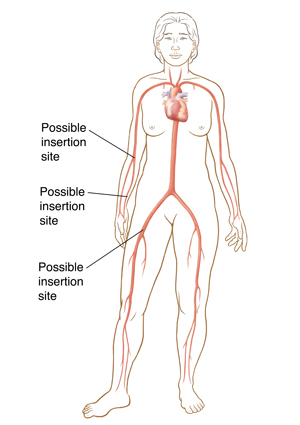A
B
C
D
E
F
G
H
I
J
K
L
M
N
O
P
Q
R
S
T
U
V
W
X
Y
Z
Topic IndexLibrary Index
Click a letter to see a list of conditions beginning with that letter.
Click 'Topic Index' to return to the index for the current topic.
Click 'Library Index' to return to the listing of all topics.
Having Cardiac Catheterization
You may have had chest pain (angina), dizziness, or other symptoms of heart trouble. To help diagnose your problem, your healthcare provider may advise a cardiac catheterization. This is a procedure that looks for a blockage or narrow area in the arteries around the heart. These can cause chest pain or a heart attack if not treated. It can also be used to evaluate other problems with your heart.
This common procedure may also be used to treat a heart problem. It may be done as a planned procedure if you've had chest pain in the past. Or it may be done right away to treat a suspected heart attack.
 |
| The catheter may be placed in the arm or the groin. |
During the procedure
-
Hair may be trimmed where the catheter will be inserted. This may be in your leg (groin), wrist, or arm.
-
You may be given medicine to relax before the procedure.
-
You'll be given a local anesthetic to prevent pain at the insertion site.
-
A healthcare provider inserts a tube (sheath) into a blood vessel in your groin or arm.
-
Through the sheath, a long, thin tube called a catheter is placed inside the artery. The catheter is then guided toward your heart under X-ray guidance.
-
The catheter can then be used to measure pressures in the heart. It can take blood samples if needed. It can also be used to inject contrast into the heart arteries to look for blockages. This is called angiography.
After the procedure
-
Your healthcare providers will tell you how long to lie down and keep the insertion site still.
-
If the insertion site was in your groin, you may need to lie down with your leg still for up to 6 or more hours. A stitch (suture) or closure device such as a collagen plug may be used on the artery site to close the site. If so, you may be able to move sooner. This depends on any bleeding that occurs.
-
If your arm was used, you may need to wear a special type of immobilizing device and pressure bandage for a few hours after the procedure.
-
A nurse will check the insertion site and your blood pressure.
-
You may be asked to drink fluid. This is to help flush the contrast liquid out of your system.
-
Have someone drive you home from the hospital.
-
It’s normal to find a small bruise or lump at the insertion site. This should go away in a few weeks.
When to call your healthcare provider
Call your healthcare provider right away if you have any of these:
-
Pain, swelling, redness, warmth, bleeding, or fluid leaking at the insertion site
-
New, severe back pain or chest pain
-
Inability to pee
-
Blood in your urine, black or sticky stools, or any other kind of bleeding
-
Fever of 100.4°F ( 38.0°C) or higher, or as advised by your provider
Call 911
Call 911 if you have any of these:
-
Chest pain or pressure, nausea or vomiting, profuse sweating, dizziness, or fainting
-
Shortness of breath or trouble breathing
-
Severe pain, coldness, or a bluish color in the leg or arm where the catheter was inserted
-
Sudden numbness or weakness in arms, legs, or face, or difficulty speaking
-
The puncture site swells up very fast
-
Bleeding from the puncture site doesn't slow down when you press on it firmly
Online Medical Reviewer:
Callie Tayrien RN MSN
Online Medical Reviewer:
Stacey Wojcik MBA BSN RN
Online Medical Reviewer:
Steven Kang MD
Date Last Reviewed:
2/1/2022
© 2000-2024 The StayWell Company, LLC. All rights reserved. This information is not intended as a substitute for professional medical care. Always follow your healthcare professional's instructions.